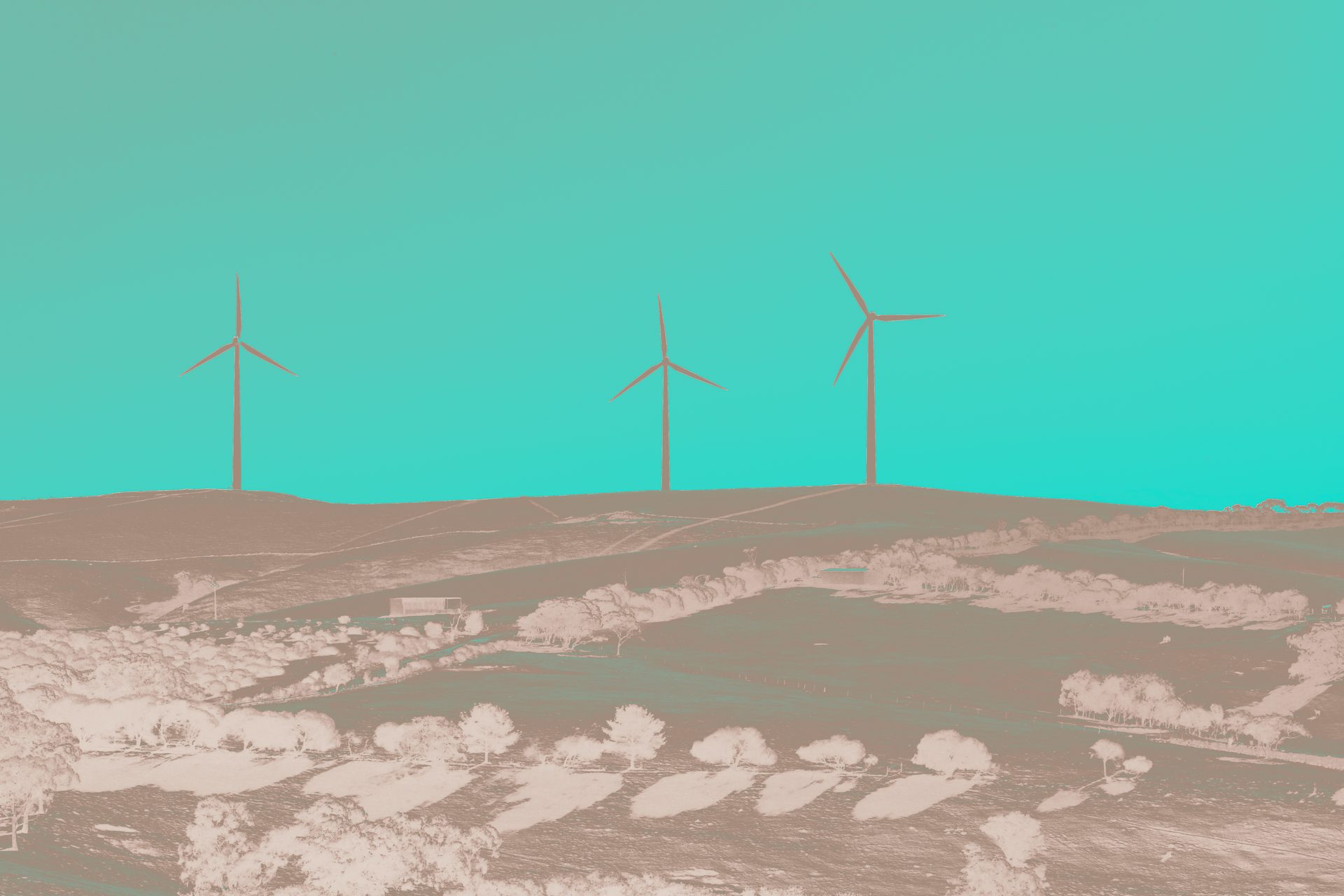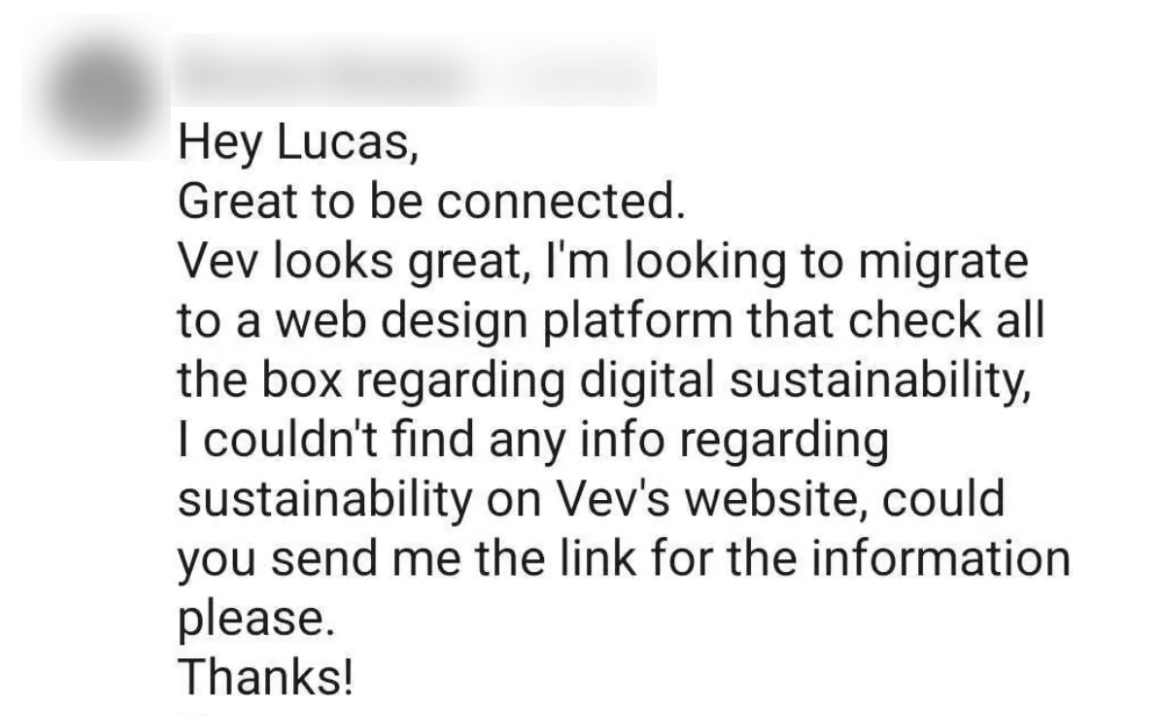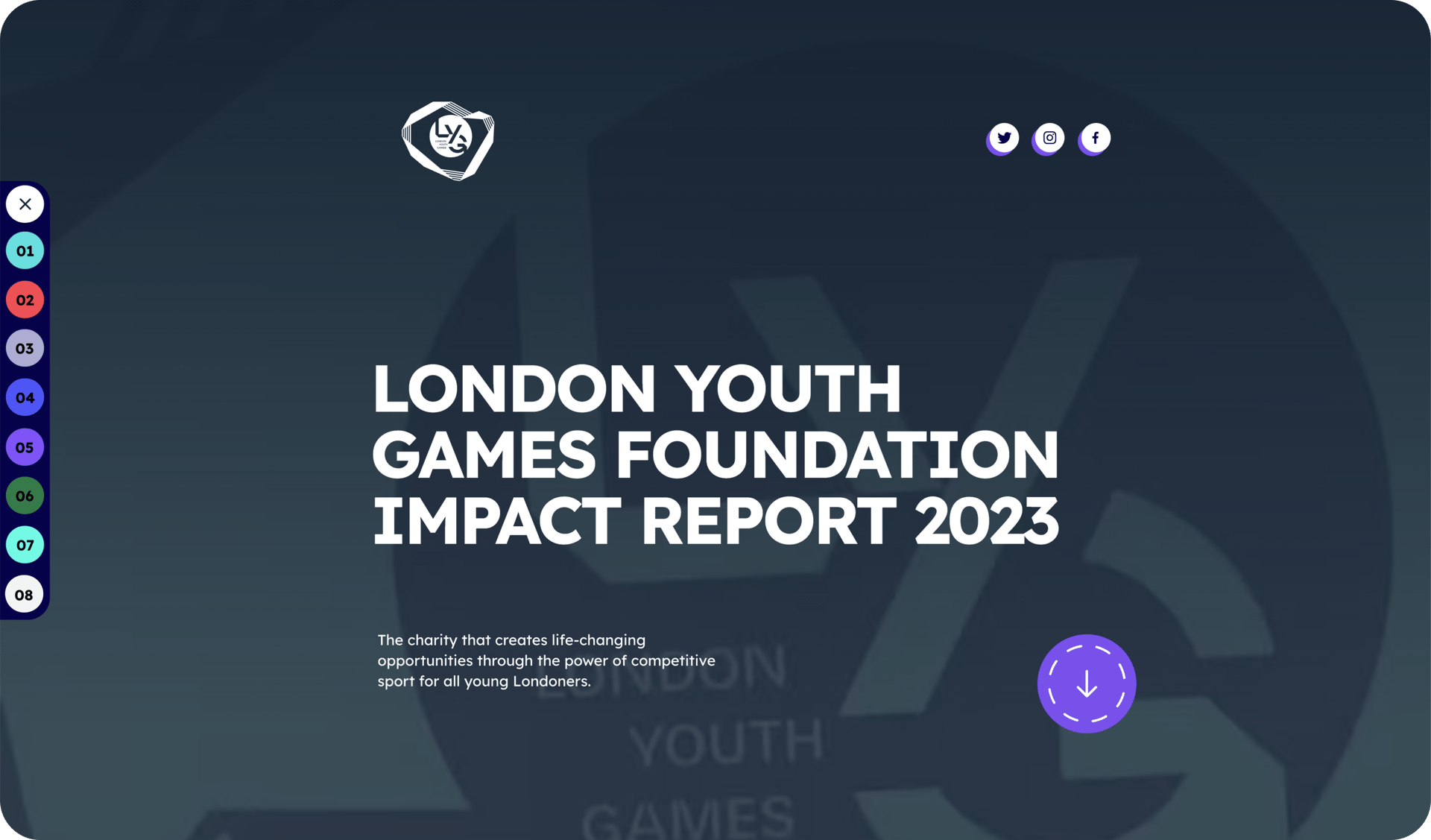How To Approach Digital Sustainability
April 19, 2022
Words by Malin Cornelia Tararr

It was a regular day on the job, reaching out to people we want to partner with on LinkedIn. Then all of a sudden, this message appeared in my inbox:

What is digital sustainability?
This much we know: we are in the midst of a scaling global climate emergency and are failing to reach the 2050 UN climate goals. In the words of António Guterres, Secretary General of the United Nations, “The battle to keep the 1.5-degree goal alive will be won or lost in this decade.”
In this context, the term "digital sustainability" might at first be interpreted as part and parcel of a general sustainability imperative—a rallying term to pressure tech businesses to do their bit to support environmental conservation.
Yet, the "digital" part actually represents something more pointed—and uncomfortable. It highlights that the virtual tools and technologies we’re using in day-to-day business themselves have a huge impact on the environment, and that if sustainability is to be incorporated through all aspects of business, these products must be designed, adapted, and directed towards addressing global sustainability targets.

What's driving digital sustainability?
Countless technologies are forming the digital toolbox of solutions that challenge the status quo—we literally have tech for everything.
In the peer reviewed study Digital Sustainability and Entrepreneurship: How Digital Innovations Are Helping Tackle Climate Change and Sustainable Development (2021), Merill et al. argues that the heightened attention to climate emergency and the rapid digitalization of our economy are two seemingly contrasting trends in business. While the urge for a more sustainable world is increasing, so is technology and how it impacts our lives.
The study suggests that:
- AI (Artificial intelligence) will add 14% (that’s 15.7 trillion) to the global economy by 2030.
- IOT (Internet of things) promises to connect billions of devices in webs of autonomous communication to make life "easier" (smart housing, infrastructure in cities and transportation, and more).
- Blockchain technology aims to reorganize transactions to be fairer, more decentralized, more efficient and more reliable.
Yet even digital products and technologies come with an environmental cost. Buying tech gadgets or using any kind of online (cloud) service consumes carbon and energy. Cryptocurrencies in particular have drawn a lot of attention in recent years for their staggering carbon footprints—Bitcoin is estimated to emit nearly as much carbon dioxide into the atmosphere every year as New Zealand.
Lazano (2019) argues that the internet itself (where most of our technology lives) is "the largest coal-fired machine on the entire planet", estimating that by 2030, the internet will account for 20% of global electricity demand (that is more carbon than any country except China, India, and the United States). And we’re not even including the throw-away culture of hardware, like updating your iPhone with every new release.
Approaching digital sustainability
In our current climate crisis, is it possible to be an ethical tech consumer, and more importantly, an ethical tech provider? If so, how should we go about it? Is the answer for us all to be more like businesses such as Low-tech magazine and power our websites using solar panels?
It's a great start. On a political and personal level, we must ask more of the biggest tech polluters—big-server owned houses like Facebook (Meta), Google, Microsoft, and hardware suppliers like Apple and Samsung—forcing the agenda for a digital world where green computing and renewable energy are the only way for a digitally-sustainable future.
At Vev, the biggest portion of our digital carbon footprint comes from our contracts with Google, Cloudflare, and Netlify—the servers we depend on to keep our platform and your content up and running. Here is what our suppliers are promising:
- Cloudflare (one of the world’s largest and most interconnected networks) has promised to only operate on 100% renewable energy. Cloudflare will also compensate for all its historical carbon emissions by 2025.
- Netlify is a CDN (JAMstack) hosting provider and is Vev’s "standard hosting" option. A JAMstack website is pre-built and serverless. In other words, content is generated in advance and distributed via a CDN (Content Delivery Network). They don’t have servers running when they don’t need them, which saves valuable time and resources.
- Google promises this: “Google is carbon neutral today, but aiming higher: our goal is to run on carbon-free energy, 24/7, at all of our data centers by 2030. Plus, we’re sharing technology, methods, and funding to enable organizations around the world to transition to more carbon-free and sustainable systems.”

How can we make our products more digitally sustainable?
Of course, there is a portion of our carbon footprint that we as a tech company can directly control: the energy required to build and use our products. Here are a few ways that we are approaching this at Vev:
- Static websites created in Vev are among the lowest energy-consuming websites out there. When you visit a regular Wordpress page (PHP), each hit usually triggers a process on a server, queries a database, compiles the HTML, and then delivers it. With Vev's static content, all that has already been done. In layman’s terms, cached and compressed content has a lower carbon footprint than server side rendering, so the data doesn’t travel as far.
- Media assets, such as images, are generated dynamically and in cached versions (which are smaller in size than the original).
- Video assets are compressed with Amazon AWS Elastic Transcoder, resulting in a high compression rate.
- Our Oslo HQ runs on completely renewable energy (Norwegian power = most sustainable in the world), and we have policies in place to minimize energy usage wherever possible. We also have a strict policy on new gadgets: you don’t get new hardware unless you really need it to do your job.
Since Vev gives its users the ability to host their website on any server of their choosing—instead of the ones offered by default—it's not possible to measure the sustainability of each and every website made in Vev. That may be a downfall of allowing more flexibility for our users, but we can certainly do more to boost education around the most sustainable ways to host a website.
Digital sustainability is a journey
We understand that digital sustainability is an ongoing commitment, not something you take a look at once and forget about. We are committed to keeping ourselves informed, exploring what we can do better, and being completely transparent with what we've done so far to address digital sustainability in our cloud infrastructure and workplaces. If you have ideas for what we can do better, please get in touch.
Resources
George G, Merrill RK, Schillebeeckx SJD. Digital Sustainability and Entrepreneurship: How Digital Innovations Are Helping Tackle Climate Change and Sustainable Development. Entrepreneurship Theory and Practice. 2021;45(5):999-1027. doi:10.1177/1042258719899425
https://cloud.google.com/sustainability
https://www.netlify.com/sustainability/
https://newrepublic.com/article/155993/can-internet-survive-climate-change
We’re seeing this play out through the proliferation of low-code and no-code platforms in recent years. They have given non-tech savvy individuals the opportunity to become citizen developers and build apps that resolve business hiccups without spending countless hours learning complex programming languages or relying on costly IT departments. That’s because these tools and platforms employ intuitive “drag-and-drop” elements and visual interfaces which allow users to design and build customized web and mobile solutions that adapt to and solve ever-changing business needs. With a little bit of gumption, imagination and the right tools in hand, the ability to innovate and create in the digital realm is now within reach.
65% of app development is predicted to be low-code by 2024 (paywall) (supplemental source: Forbes)
More than 60% of large companies will use 4 different low-code app building platforms (paywall) (supplemental source: Forbes)
The low-code platform market is estimated to increase to $21.2 billion in 2022, up from $3.8 billion in 2017 (paywall) (supplemental source: Forbes)
- The global low-code platform market revenue is forecast to reach approximately $65 billion U.S. dollars in 2027, up from almost $13 billion in 2020.
- 88% of executives believe technology democratization is becoming critical in their ability to ignite innovation across their organization.
We’re seeing this play out through the proliferation of low-code and no-code platforms in recent years. They have given non-tech savvy individuals the opportunity to become citizen developers and build apps that resolve business hiccups without spending countless hours learning complex programming languages or relying on costly IT departments. That’s because these tools and platforms employ intuitive “drag-and-drop” elements and visual interfaces which allow users to design and build customized web and mobile solutions that adapt to and solve ever-changing business needs. With a little bit of gumption, imagination and the right tools in hand, the ability to innovate and create in the digital realm is now within reach.
65% of app development is predicted to be low-code by 2024 (paywall) (supplemental source: Forbes)
More than 60% of large companies will use 4 different low-code app building platforms (paywall) (supplemental source: Forbes)
The low-code platform market is estimated to increase to $21.2 billion in 2022, up from $3.8 billion in 2017 (paywall) (supplemental source: Forbes)
- The global low-code platform market revenue is forecast to reach approximately $65 billion U.S. dollars in 2027, up from almost $13 billion in 2020.
- 88% of executives believe technology democratization is becoming critical in their ability to ignite innovation across their organization.
of large companies will use 4 different low-code app building platforms (paywall) (supplemental source: Forbes)
0
%
of executives believe technology democratization is becoming critical in their ability to ignite innovation across their organization.
0
%
of app development is predicted to be low-code by 2024 (paywall) (supplemental source: Forbes)
0
%
"The web belongs to all of us."


Want More Inspo?
Get our monthly newsletter straight to your inbox.
You can always unsubscribe at any time.
Privacy Policy
























